California Forever has made its first substantial step toward building a new city on agricultural land in Solano County. Earlier this week, YIMBY spoke with California Forever’s Head of Planning, Gabriel Metcalf, to discuss the facts of their proposal and the Ballot Initiative. The company, a real estate firm established in Silicon Valley in 2017 with financing from several billionaires, hopes to convince the county voters to create a new city with up to 400,000 residents.
The initiative [published here] is a legally binding document to let California Forever negotiate with Solano County. In the document’s own words, the vote is “requesting voter approval to authorize a new community through amendments to the General Plan and… Solano County ‘Zoning’ Code.” Voters will be deciding this November.
California Forever was founded in 2017 by the then-30-year-old Jan Sramek. The sales were made using an anonymous company named Flannery Associates LLC. It is believed the origins go back to the first plot of land purchased in 2018 by Route 113 and Flannery Road. Over the years, its increased activity attracted ever-increasing speculation by residents and public officials alike. Last year, California Forever stated it spent around $800 million to acquire land.
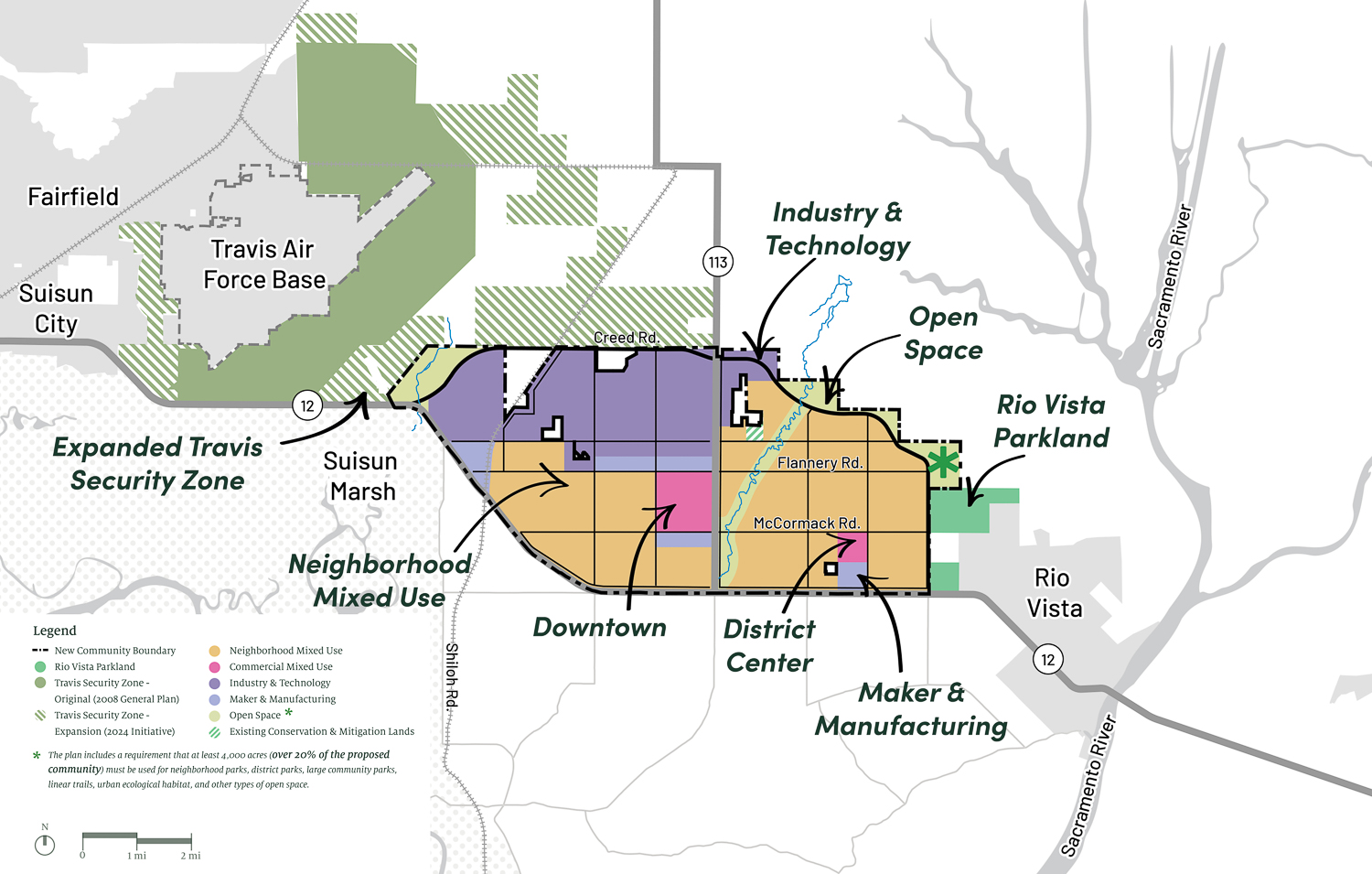
California Forever proposed zoning map, rendering by SITELAB Urban Studio and CMG
In August last year, the New York Times revealed several Silicon Valley billionaires had invested. The reporting includes a message in 2017 from the prominent venture capitalist Michael Moritz, who pitched to investors that “the return could be many times the initial investment just from the rezoning, and far more if and when they started building.” Other multi-billionaire investors reported on by the Times include Marc Andreessen and the investment firm he co-founded, Andreessen Horowitz, Patrick & John Collison, Chris Dixon, Nat Friedman, Reid Hoffman, and Laurene Powell Jobs.
An important note is that California Forever’s project will not be an incorporated city with local government. The development will remain on unincorporated Solano County land overseen by the County Board of Supervisors. The project’s zoning will be decided through the upcoming ballot initiative. If the initiative is successful, the developer will draft an Environmental Impact Report and then negotiate the development agreement with County officials.
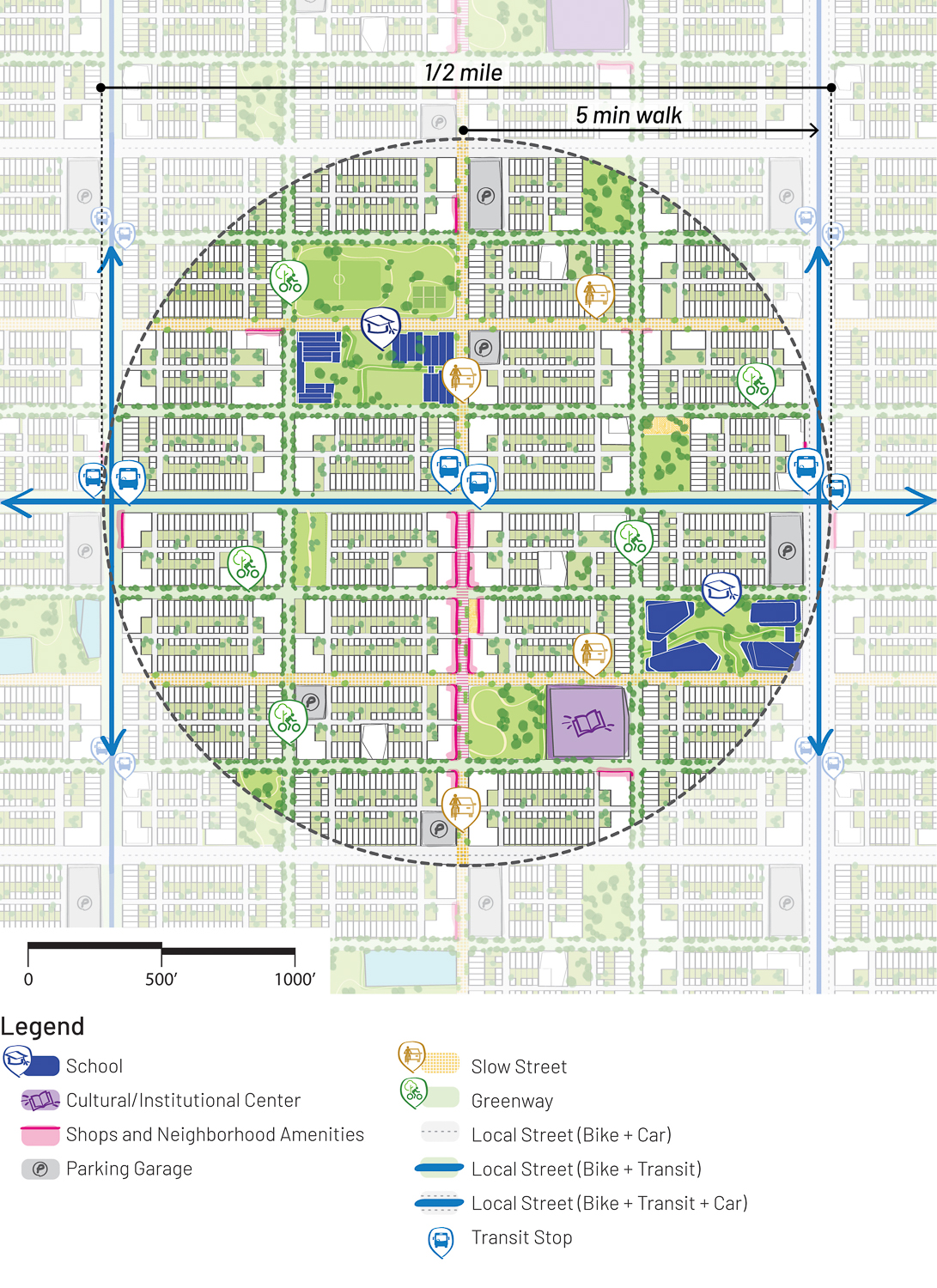
California Forever illustrated example of a neighborhood street plan, rendering by SITELAB Urban Studio and CMG
The core facts of the proposal, as described in the ballot Initiative, give a broad overview of the potential city. The proposal will develop under 30% of its owned land or 17,500 acres out of roughly 60,000 acres. The surrounding area will remain agricultural, become open space, or be used for solar farms.
The master plan aims for a total build-out of 40,000 to 160,000 dwelling units and 25 to 90 million square feet of non-residential development. That could see the city occupied by 100,000 to 400,000 residents. The ballot initiative calls for a minimum density of 20 units per acre and a build-out timeline of approximately 40 years. The general plan includes higher density in the downtown district and specialized zoning for industry closer to Highways 12 and 113.
While its highest potential build-out would nearly double Solano County’s current population of roughly 450,000 people, even the lower projection would exceed the county’s mandate from the State to approve 11,000 new units. However, before several cities get optimistic, the current structuring of Regional Housing Needs Allocation does not let the rest of Solano County skirt their responsibilities.
The project team collaboration with California Forever is driven by several local firms. The two most visible design aspects will be overseen by San Francisco-based studios: urban planning by SITELAB Urban Studio and landscape architecture by CMG. Two San Ramon-based companies will oversee engineering, ENGEO and CBG. Daly City-based EKI will be responsible for water resource engineering, and the Walnut Creek-headquartered engineers at Fehr & Peers will oversee transportation.
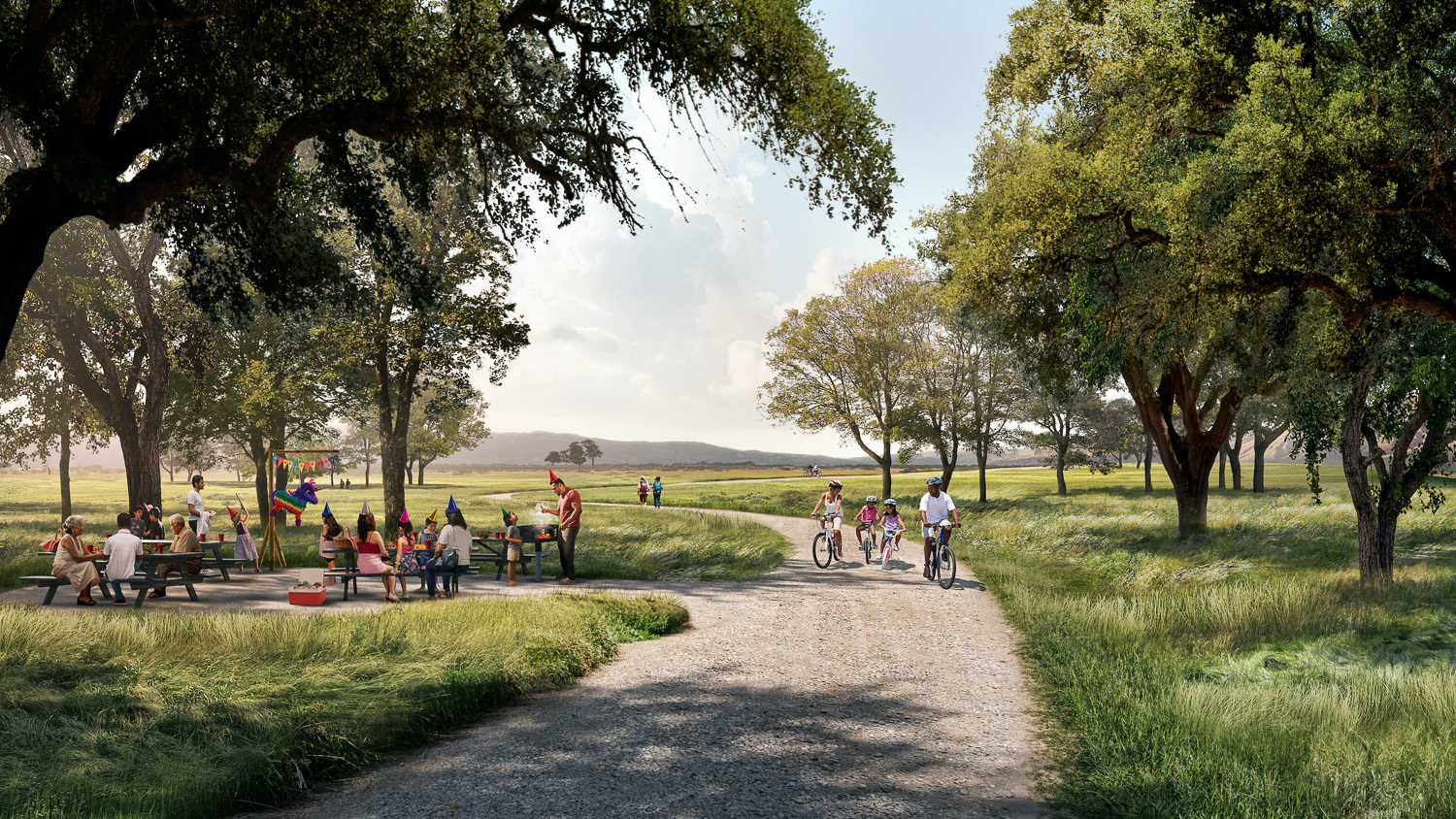
California Forever pedestrian view of a potential park, rendering by SITELAB Urban Studio and CMG
Interview by Rick Totten for SFYIMBY. Text has been edited for clarity.
YIMBY: How did you first get involved in the project?
Gabriel Metcalf: I met Jan Sramek, who’s now the CEO, back in maybe 2017, and a mutual friend introduced us and said you guys are both obsessed with new cities.
YIMBY: Several proposals have been made over the years by people wanting to build new cities. Some have gone well, some haven’t. What persuaded you that this one was a good idea?
Gabriel Metcalf: I always was interested in the British New-Town movement from, you know, planning school learning about Ebenezer Howard and the Abercrombie Plan. I think it’s a really important influence on new urbanism here, certainly. It always made sense to me that in places that are dealing with really high rates of population growth or demand on the housing side, new towns would be a really useful strategy. So that’s one thing.
If you look at the places in the US that are walkable urban places today, virtually all of them already existed by 1900. And I think that is the root of so many of our problems. We have lost the art of city building. If we could rediscover how to make walkable places again, it would take the pressure off the cities that have gotten so expensive.
I think it just cannot be good for our society to be in a situation where it is either illegal or impossible to create new walkable places. When I got the opportunity to work on this, I jumped at it.
YIMBY: One thing I’d be interested to understand is, this proposal is looking to create a pretty wide-ranging, flexible permission for development, which will only have ministerial approvals for the vast majority of things going forward. That sounds great from a developer’s perspective. But how will the people and elected officials of Solano County maintain kind of checks and balances over this 40-year build-out?
Gabriel Metcalf: There are two primary ways that voters in Solano County maintain democratic oversight. One is the terms of the voter initiative themselves, which are legally binding. Those have been developed through intense consultation with the people and elected leaders in the county. It includes funding commitments, a zoning envelope, and a development footprint. So, all of that is locked in by a vote of the people.
The second main way voters in the count will exert control is through the terms of the development agreement. After our process and the voter initiative, we do a full EIR (Environmental Impact Report) and then negotiate a development agreement with the county board of supervisors. A development agreement is a voluntary contract in which both parties can agree to whatever they choose.
That will be an extensive process. And so, you know, for example, the ballot measure locks in the funding commitments in terms of dollar amounts, but the detail on how that gets spent is to be negotiated in the development agreement.
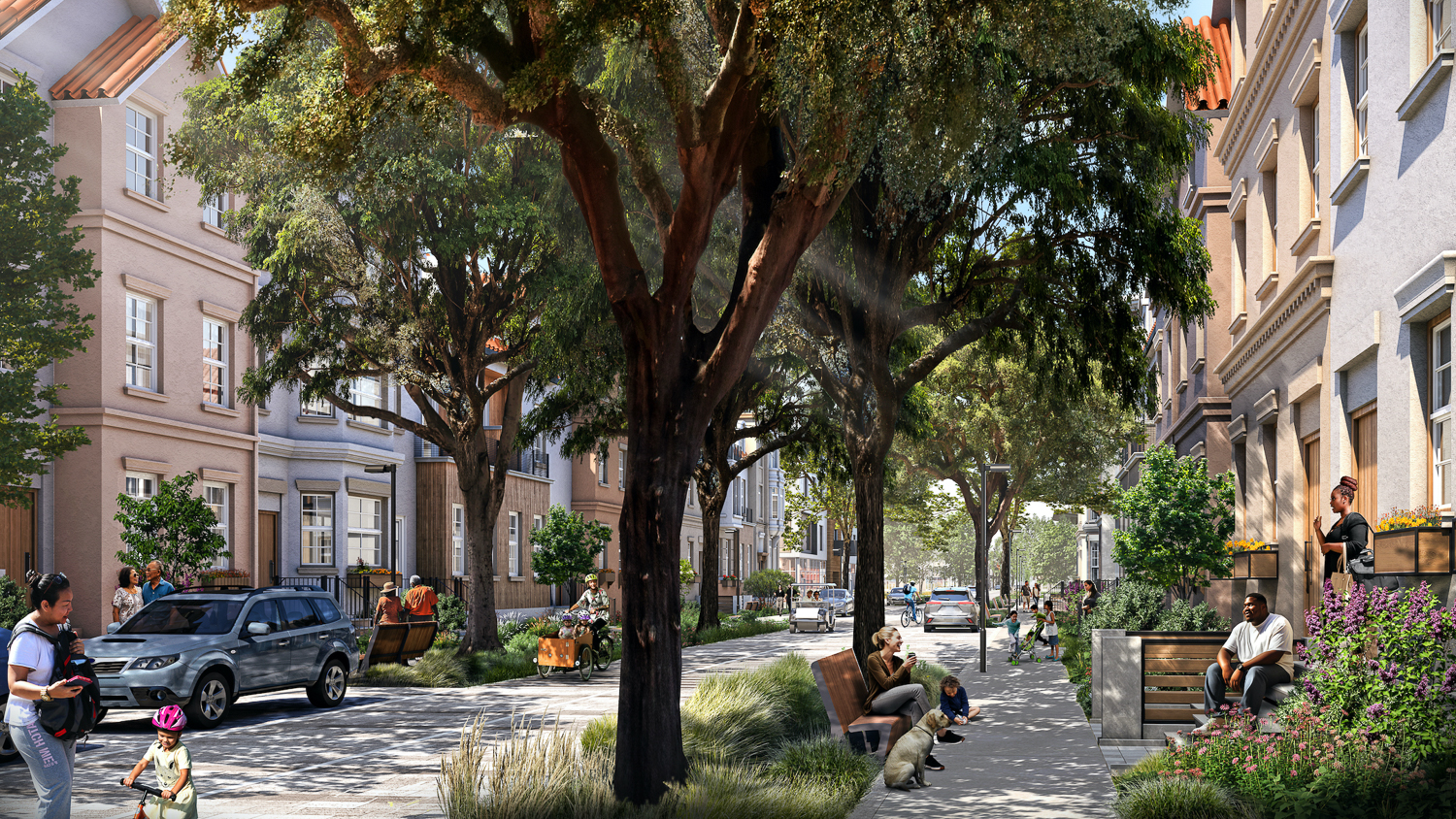
California Forever conceptual street view, rendering by SITELAB Urban Studio and CMG
YIMBY: That certainly makes sense on the funding side. I haven’t seen any mention of an architectural review of individual buildings. So, how will architectural standards and harmonious development be maintained?
Gabriel Metcalf: I would say we think the traditional way that design review normally works in California is a total failure. We’re trying to set up a really different process that will involve a simple design code. Our goal is that a complying project can be approved in 10 days. We’re not looking to have people involved in telling other people what they can build.
YIMBY: Will there be any kind of government or further regulation? Parking is one thing, under or over the provision of parking for buildings, or cycle spaces, or that kind of thing. Will that be governed in any way?
Gabriel Metcalf: Some of that will be in the voter initiative, and some of that will be in the development agreement. The voter initiative sets minimum parking at zero across the entire city. We don’t think that the way that regulation of development standards has worked in recent decades in California is a good model.
YIMBY: So, there won’t be any kind of local government that runs this city apart from the county government?
Gabriel Metcalf: Yes, our intention is to remain part of unincorporated Solano County. So, the political body that will have jurisdiction is the county board of Supervisors. We’ll have a very close cooperative working relationship with the county to provide police and fire services, all the services, and work on economic development projects together. I expect we’ll be very close partners.
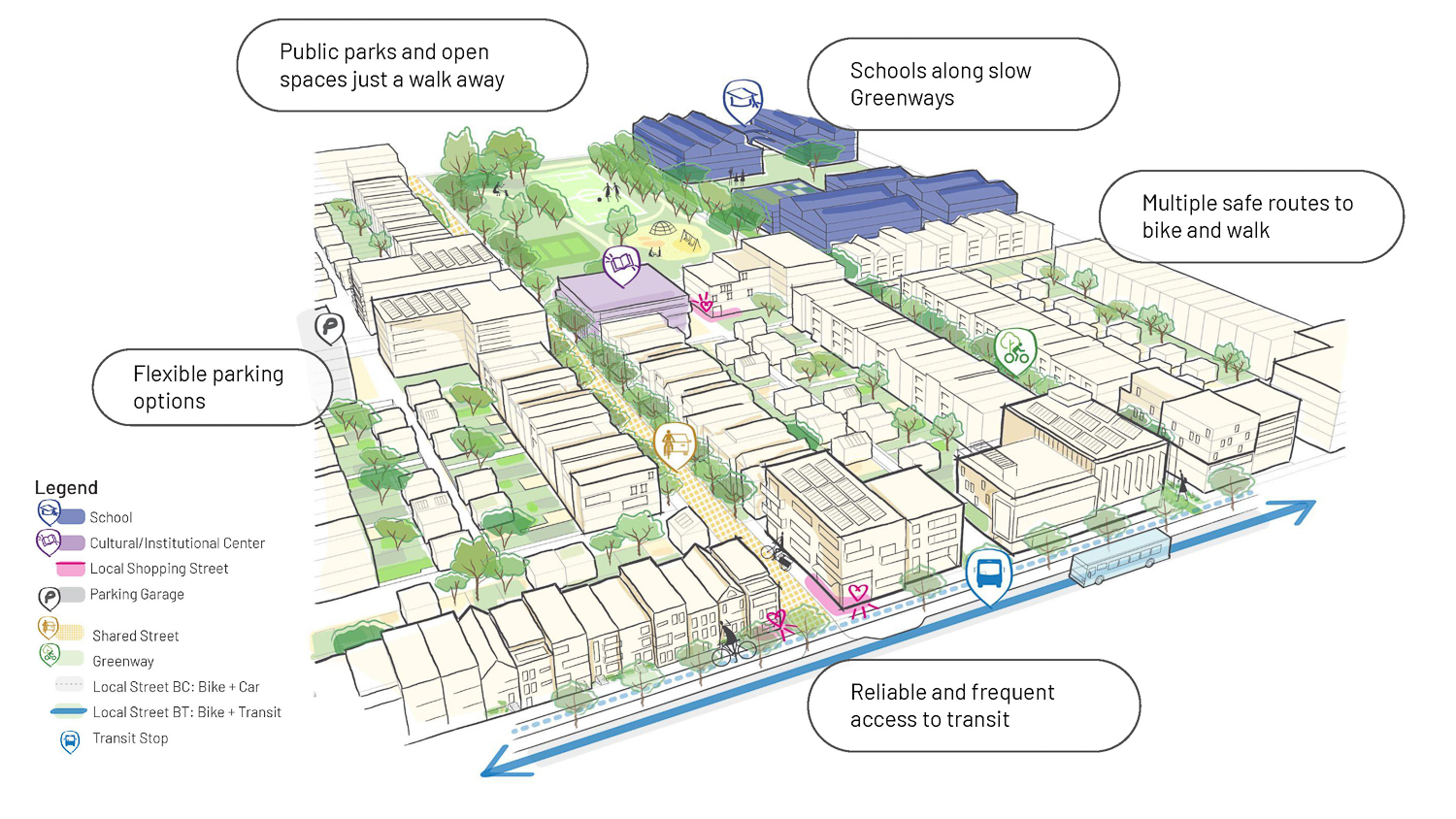
California Forever visual for the neighborhood design concepts, rendering by SITELAB Urban Studio and CMG
YIMBY: There is an awful lot of construction for someone to do. Just to understand how that might be structured, will California forever act as a master developer, building all the infrastructure and highways and public facilities, whatever that is required, and then sell off plots to developers?
Gabriel Metcalf: That’s exactly what the model is. We’d like to be the master developer and secure the entitlements, build out the infrastructure, and then bring in vertical development partners, both small ones and big ones, to build the city over time.
YIMBY: So, you have to start somewhere. Many of the principles that California Forever aims for, like public transit, local shopping, and many services within a 10-minute walk, depend on a critical mass of people. How are you going to get that working from day one?
Gabriel Metcalf: We spent a lot of time thinking about this concept of critical mass and the minimum number of households you need for various things. It’s different for different topics, but we think one of the reasons why many large-scale developments have failed to deliver on things like retail is that they were too small and they didn’t achieve critical mass.
The whole logic behind the densities in the city plan is to put enough customers within walking distance of each local shopping street so that small businesses can succeed. That is something that is almost never done anymore in master developments.
The basic answer to the question of ‘what do you do before you get to critical mass’ is we have to subsidize the services and amenities so that they exist much earlier than they could exist if they were purely dependent on the population that’s there.
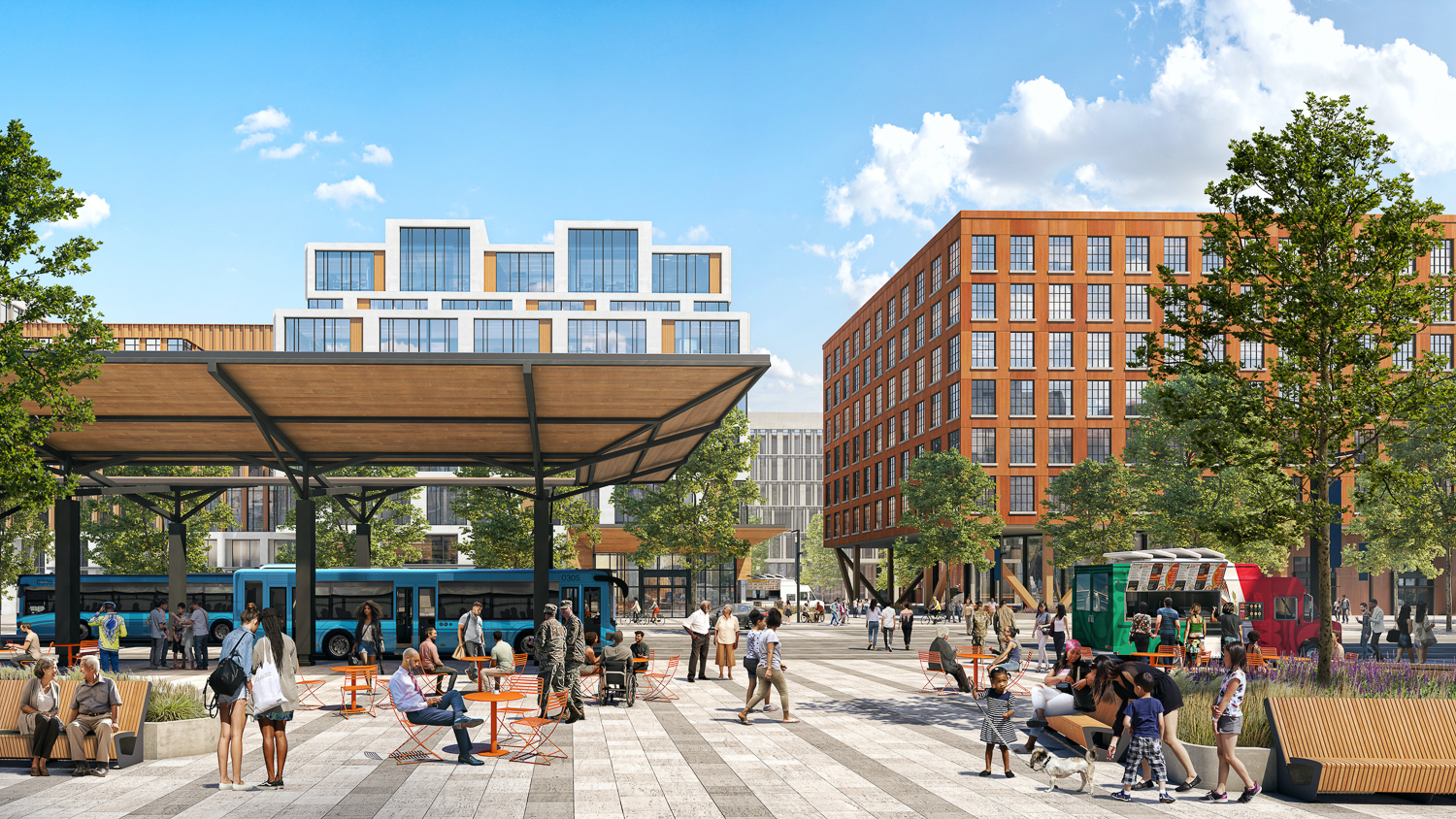
California Forever conceptual downtown plaza and transit stop, rendering by SITELAB Urban Studio and CMG
YIMBY: The discussion about transportation is linked to that question around critical mass. The internal transportation looks really well thought out with the alleyways and the local community streets, and the grid pattern. But the kind of criticism I’ve seen is about the external transportation connections.
Gabriel Metcalf: Oh yes, Benjamin Schneider wrote a piece. One thing that I feel has not been widely noticed is that after we filed the ballot measure, we got feedback from the county. We ended up making a bunch of edits at their request. Because I got the chance to read that piece, we were able to insert a new passage spelling out something we had already been planning to do, making it more transparent and explicit.
We are required to provide for rail, should it ever become possible. We are building a rail-ready community. That means it’s compact with a central transit station that everybody can access. The local internal planning makes it capable of being connected to a regional network. However, it’s not only up to us. We need to be working with the regional and state transportation agencies in order to do it.
On one level, transportation is just like water, electricity, or sewers. It’s a physical infrastructure that we have to build, and it’s part of the cost of building a new town. It is part of our business model that we must bear the costs of building transportation connections.
The only thing that is a little different and why it’s not developed fully in the ballot measure is that a county ballot measure cannot tell CalTrans, CalSTA, MTC, BART, or Capitol Corridor what to do. We will be working with all of those regional agencies, and I think it sort of goes without saying the city can’t grow past a certain point unless we are successful in building those external connections. I think we’re completely in agreement that we have to build external public transit.
What we will be able to do in the short run is operate a rapid shuttle program, meaning buses. Over the next year, we will be working out the service plan, which destinations and frequencies, operating hours, and vehicle type… We will operate a very robust public transit system from day one. In the longer term, we would like to build new and better connections.
Subscribe to YIMBY’s daily e-mail
Follow YIMBYgram for real-time photo updates
Like YIMBY on Facebook
Follow YIMBY’s Twitter for the latest in YIMBYnews

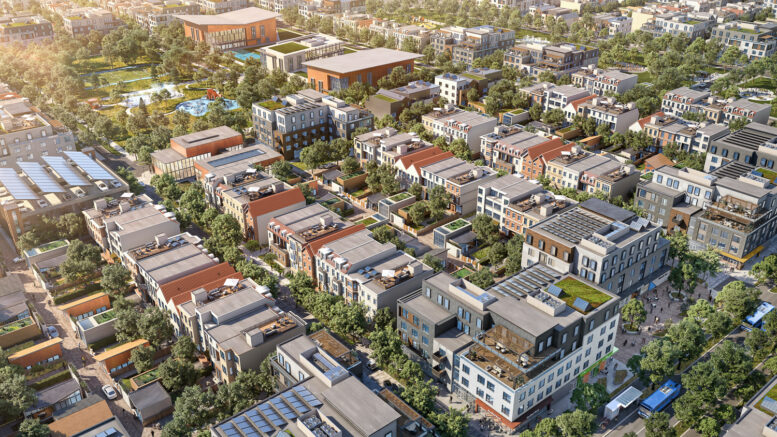
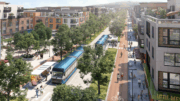

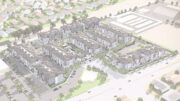
This whole situation is so strange. The renderings of this planned community area an urbanists dream, if it was completed as proposed in the renderings it would literally be one of the best planned communities in the united states. And even if it never got good transit connections would probably still be a dense walkable place with lots of green space. However, I just can’t get past the fact that the amount of money that was spent to purchase all this land could have been used to improve vast areas of our existing cites. They could have bought up entire industrial districts or entire neighborhoods. They could have funded a BART expansion to lower cost areas or funded a light rail system to reach underserved (and underdeveloped) parts of the East bay or north bay. The amount of money they spent on this pet project that will take (at best) multiple generations to create could have had an instant impact to the existing people living throughout the Bay Area. I think its a perfect distillation of the Rich American urge to create from a blank slate instead of trying to improve and perfect what we already have.
Isn’t the assumption that the current cities are just broken? I would guess that the people who put up the money for this feel that spending to improve the existing infrastructure would be like “rearranging the deck chairs on the Titanic” … that SF is broken… you just need to start over again… from the ground up.
That’s what rich tech bros always say. Start over fresh (ruining this landscape in the process) because I know best. I hope, and trust, that Solano County voters will see through all the bs and vote this thing down (by a huge margin).
I’ll give you that it sounds a bit idealistic. Although, I don’t understand the boogeyman argument/blaming so-called tech bros for trying to build housing given the standard approach is unavoidably flawed. Cynicism aside, the developer’s intentions seem focused on a net positive that provides people a place to live in a walkable, healthy urban(ish) environment that emphasizes local thinking and that sounds good.
You can’t put cynicism aside as it’s at the heart of this ridiculous proposal. The developers proposals seem net focused on trying to make more money. Full stop. There’s nothing idealistic about it at all.
Right, emphasizes local thinking by secretly buying up tens of thousands of acres of land sometimes getting the lawyers out to force sales, then having to force a county wide vote to overrule the long-standing urban growth boundary, and then when that will invariably fail call out still more lawyers to override the will of the people of Solano County. That sounds downright local to me. /s
Agreed on all points. I do believe that parts our our exisiting urban fabric can be transformed into communities that look like this concept. Many formerly industiral areas already are moving in this direction, like Emeryville, Brooklyn Basin, Mission Bay, etc. While the concept pushed by Forever California is better than single family suburban sprawl, it is also just sprawl, with high costs in devleoping and maintaining utilities, all so that private equity can revitalize their bottom lines with new real estate. They want to own the new propoerty, not invest and improve what we have. Our cities can get way more dense before we sacrifice more urban-rural interface.
“However, I just can’t get past the fact that the amount of money that was spent to purchase all this land could have been used to improve vast areas of our existing cites” “I think its a perfect distillation of the Rich American urge to create from a blank slate instead of trying to improve and perfect what we already have”
I get this point wholeheartedly, but the point of this project is to alleviate living cost and homelessness problems so San Francisco and the other Bay Area cities can follow suit. So they’re not being neglected in this whole plan, which I’m happy about
Everything that you say is not true. Literally everything. There’s NO WAY this ridiculous plan will ever do anything to alleviate homelessness in San Francisco. None. And to say that it will is the worst kind of myopia. And this silly statement that the rest of the Bay Area cities can follow suit is just more blather. If these rich tech bros were interested in the rest of Bay Area cities following suit they’d have done that TO START. I hope Solano County voters keep the eye on the ball and vote this monstrosity down.
You miss the point, CA immediately short of 11,000 house now. This project will take 40 years to build out, will constantly be the job creation site not only for 1-4 years but to continue 40 years. Fairfield will have a new city called Newfield just for example. Besides, it is not easy to modify what already existed to be a 5 min City, it is inefficient to tear down and rebuild. This will save a lot of CO2 emission requiring no car or less car to live here. Capitalism is helping Socialism objective in a way, we just have to think deep to understand why Capitalism had benefited everyone so much over the past 250 years.
This isn’t “thinking deep.” It’s a bunch of billionaire tech bros trying to make more money. It’s same ol’ same ol’ and if you think a new city built in the middle of literally nowhere that’s disconnected completely from the surrounding region will reduce greenhouse gases you really haven’t any reason to be taken seriously.
It is crazy it has come to creating a whole new City. California has made it so difficult to build anything walkable or fine grained. I just hope the this attracts quality design and development, not the Track Home developers and their foam stucco trimmed, poorly proportioned snout houses. This master plan could get very tacky, very quickly without some checks. Project planning submittals should have reading requirements like the “Get Your house Right” or “101 Things I Learned in Urban Planning School” with a 20 question quiz, that would be amazing to see!
It won’t be better. It’ll be Mountain House same ol’ same ol’ stucco sprawl garbage and should be rejected as should have been done with Mountain House.
Bro, what is your ideal solution? I realize we need to neutralize the boogeyman (Tech bros) and live in a bureaucratic nightmare (city of SF) to authentically indulge our urbanist fantasies, but do you honestly believe we’ll be able to course correct quickly enough and make building housing in cities affordable, well-designed and appropriately walkable before the real doom sets in?
My “ideal” solution is to build in the cities that we’ve already got. I’ve already seen massive new building in Oakland and even downtown Berkeley not to mention San Francisco. Take a look at the SF skyline from 2000 compared to today and if it’s not enough build more. Saying tech bro is not a boogeyman if it’s true. California is not something to be strip mined for more profit.
Who would live here without a Bart or Amtrack connection?
I agree with Chris. He worded it so well. They should have used this money for a BART extension to and under served community like Vallejo.
Mare Island would be the perfect place for a planned community with all it’s open space and location.
Looking at the map, this project is between the Fairfield Amtrak stations and Antioch BART station. So I wouldn’t be surprised if a bus line was introduced through this planned city to connect them
Also I completely agree with Mare Island being a perfect spot for development. Especially since there are existing railroad tracks there that go up to Napa
Ooh. A bus line! This monstrosity should be voted down by Solano County voters and I have no doubt that it will be. This horrible proposal would suck all the development oxygen from every other city in the county. This is just more car centric global warming sprawl.
Why didn’t they take advantage of the closeness of the Sacramento river? Every ‘charming’ town you see worldwide is built on a river.
Directly within a floodplain even!
i spy multiple mediocre 5 over 1 soulless box style modern buildings. Please for the love of god yall have the chance to do something special here. Do not ruin this clean slate by polluting it with that hideous style of building.
“The company, a real estate firm established in Silicon Valley in 2017 with financing from several billionaires”
Yimbys love to enrich real estate developers “for the rich children of tomorrow” but please don’t pretend any of this will actually come to pass as advertised, willing saps.
On governance, I don’t see a way to avoid residents incorporating at their first opportunity, as both the master planned cities of Lakewood and Irvine promptly did, to their developers’ chagrin.
On design, it’s not that one can’t plan better cities at the margin. It’s that we lack reliable utopian templates — no matter that many, many charmers claim to have one, all too happy to launch you on their favored leap of faith. There is a considerable literature on what higher density does and does not reliably accomplish, grid or not, cute or not, no matter how smooth the pitch and promises.
On function, see Rittel & Weber (1973) for classic insight into why remedies for so-called wicked problems of city building and fixing are false gods. Cities are behavioral and economic conundrums. We are far from understanding them well enough to do them well from scratch.
The best California new town model might be my home of the past few decades, Irvine, pop 300k. It works; it’s also unaffordable to all but the 1% and traffic is a bear even though the typical residential arterial speed limit is 55mph. (It further has the advantages of great weather, a nearby coast, trains and a bunch of highways.)
Yet per Waldie (1996), what it and Lakewood lack in charm, they make up for in predictability. Maybe that’s the goal here, market housing that won’t surprise anyone with shockingly better livability, but is viable enough to pay its bills.